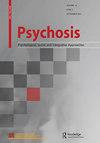Launay–Slade Hallucination Scale-Extended: simplifying its interpretation
IF 1
4区 医学
Q4 PSYCHIATRY
Psychosis-Psychological Social and Integrative Approaches
Pub Date : 2022-01-04
DOI:10.1080/17522439.2021.1983011
引用次数: 1
Abstract
ABSTRACT Background The Launay–Slade Hallucination Scale – Extended (LSHS-E) is one of the most used self-reported questionnaires to explore the multidimensionality of hallucinatory-like experiences (HLEs). This scale is defined as a 5-level Likert scale, which goes from 0-“certainly does not apply to me” to 4-“certainly applies to me.” Like any Likert scale, the LSHS-E scale assumes that the ordinal categories are equally spaced among them, which might not be true, giving rise to possible issues in offering a valid interpretation of the responses. Method This study introduces a parametric model: the ordered stereotype model. This model determines the uneven spacing among ordinal responses, dictated by the studied data. Results This work shows that the ordinal categories of the LSHS-E scale are determined both by unequal spacing and by the spacing among the last three adjacent categories, which makes them indistinguishable. Subsequent analysis showed good internal reliability, and also a four-factor structure was maintained. Discussion The current study’s findings suggest that people who suffer from HLEs might not easily disclose their experiences and so give neutral responses for fear of being stigmatized. Further, neutral responses might identify people at risk of psychosis, and individuals during the prodromal stage may not be aware of their transient or fleeting HLEs. Future research should determine the distance among the categories on a Likert scale as a first step before analyzing and understanding the data.劳奈-斯莱德幻觉量表扩展:简化其解释
劳奈-斯莱德幻觉扩展量表(Launay-Slade Hallucination Scale - Extended, LSHS-E)是一种用于探究幻觉样体验(HLEs)的多维度的自报告问卷。这个量表被定义为5级李克特量表,从0-“肯定不适用于我”到4-“肯定适用于我”。与任何李克特量表一样,LSHS-E量表假设序数类别之间的间隔是相等的,这可能不是真的,从而在提供有效的回答解释时可能产生问题。方法引入一种参数化模型:有序刻板印象模型。该模型决定了顺序响应之间的不均匀间隔,由所研究的数据决定。结果LSHS-E量表的序数类别是由等距和后三个相邻类别之间的间距决定的,这使得它们无法区分。后续分析结果表明,本研究具有良好的内部信度,并保持了四因子结构。目前的研究结果表明,患有HLEs的人可能不容易透露他们的经历,因此由于害怕被污名化而做出中立的反应。此外,中性反应可能会识别出有精神病风险的人,而处于前驱期的个体可能不会意识到他们的短暂或短暂的HLEs。在分析和理解数据之前,未来的研究应该首先确定李克特量表上类别之间的距离。
本文章由计算机程序翻译,如有差异,请以英文原文为准。
求助全文
约1分钟内获得全文
求助全文
来源期刊
CiteScore
2.20
自引率
8.30%
发文量
36

 求助内容:
求助内容: 应助结果提醒方式:
应助结果提醒方式:


